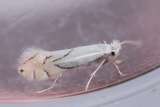Phyllonorycter harrisella (Linnaeus, 1761) Species
Last modified: Dec. 10, 2025, 4:56 p.m.
A common species throughout Belgium.
Details
- Classification
- Family: Gracillariidae > Subfamily: Lithocolletinae > Genus: Phyllonorycter > Species: Phyllonorycter harrisella
- Vernacular names
- Witte eikenvouwmot (NL), White oak midget (EN), Blattrand-Eichen-Faltenminiermotte (DE)
- Synonyms
- Phyllonorycter cramerella (Fabricius, 1777)
- First mention in Belgium
- De Sélys-Longchamps E. 1844. Énumération des insectes Lépidoptères de la Belgique. — Mémoires de la Société royale des Sciences de Liége 2: 1–35. On page 25 (as cramerella). view page
- Status
-
Native
Distribution
Mine
A rather small (max. 14 mm), semi-circular or oval tentiform mine on the underside of a leaf, with one strong central fold.
See also gracillariidae.net and bladmineerders.be.
Cocoon/pupa
A tough, white cocoon attached to the roof and the bottom of the mine. In contrast to most other Phyllonorycter species, the black frass is not concentrated in a corner of the mine but incorporated as a U-formed shape around the cocoon.
Bionomics
The egg is oviposited on the underside of a leaf.
The species hibernates in the pupal stage, inside the cocoon between the fallen leaves among leaf litter on the ground.
The pupa protrudes through the underside of the mine just before the emergence of the adult.
The adults rest on the tree trunks or the foliage. They become active at dusk and come to light.
Flight periods
Two generations a year in April–May and August–September.
Observed on
- Host plant (species):
- Quercus robur, Quercus petraea and Quercus pubescens
- Host plant (genera):
- Quercus
The caterpillar lives on Quercus, mainly on Q. robur, but also on Q. petraea and Q. pubescens.


